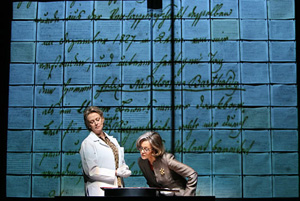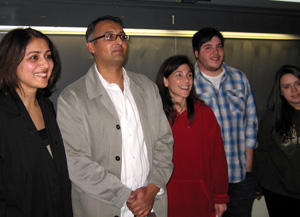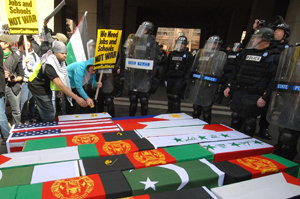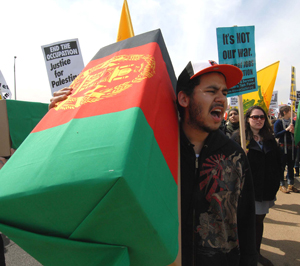zakaria makes some good points but is anyone going to listen? not sure what the agenda is anymore. war is too profitable for too many.
“Learning to Live With Radical Islam” by Fareed Zakaria
Newsweek, Feb 28, 2009
We don’t have to accept the stoning of criminals. But it’s time to stop treating all Islamists as potential terrorists.
Pakistan’s Swat valley is quiet once again. Often compared to Switzerland for its stunning landscape of mountains and meadows, Swat became a war zone over the past two years as Taliban fighters waged fierce battles against Army troops. No longer, but only because the Pakistani government has agreed to some of the militants’ key demands, chiefly that Islamic courts be established in the region. Fears abound that this means women’s schools will be destroyed, movies will be banned and public beheadings will become a regular occurrence.
The militants are bad people and this is bad news. But the more difficult question is, what should we—the outside world—do about it? That we are utterly opposed to such people, and their ideas and practices, is obvious. But how exactly should we oppose them? In Pakistan and Afghanistan, we have done so in large measure by attacking them—directly with Western troops and Predator strikes, and indirectly in alliance with Pakistani and Afghan forces. Is the answer to pour in more of our troops, train more Afghan soldiers, ask that the Pakistani military deploy more battalions, and expand the Predator program to hit more of the bad guys? Perhaps—in some cases, emphatically yes—but I think it’s also worth stepping back and trying to understand the phenomenon of Islamic radicalism.
It is not just in the Swat valley that Islamists are on the rise. In Afghanistan the Taliban have been gaining ground for the past two years as well. In Somalia last week, Al-Shabab, a local group of Islamic militants, captured yet another town from government forces. Reports from Nigeria to Bosnia to Indonesia show that Islamic fundamentalists are finding support within their communities for their agenda, which usually involves the introduction of some form of Sharia—Islamic law—reflecting a puritanical interpretation of Islam. No music, no liquor, no smoking, no female emancipation.
The groups that advocate these policies are ugly, reactionary forces that will stunt their countries and bring dishonor to their religion. But not all these Islamists advocate global jihad, host terrorists or launch operations against the outside world—in fact, most do not. Consider, for example, the most difficult example, the Taliban. The Taliban have done all kinds of terrible things in Afghanistan. But so far, no Afghan Taliban has participated at any significant level in a global terrorist attack over the past 10 years—including 9/11. There are certainly elements of the Taliban that are closely associated with Al Qaeda. But the Taliban is large, and many factions have little connection to Osama bin Laden. Most Taliban want Islamic rule locally, not violent jihad globally.
How would you describe Faisal Ahmad Shinwari, a judge in Afghanistan? He has banned women from singing on television and called for an end to cable television altogether. He has spoken out against women and men being educated in the same schools at any age. He has upheld the death penalty for two journalists who were convicted of blasphemy. (Their crime: writing that Afghanistan’s turn toward Islam was “reactionary.”) Shinwari sounds like an Islamic militant, right? Actually, he was appointed chief justice of the Afghan Supreme Court after the American invasion, administered Hamid Karzai’s oath of office and remained in his position until three years ago.
Were he to hold Western, liberal views, Shinwari would have little credibility within his country. The reality—for the worse, in my view—is that radical Islam has gained a powerful foothold in the Muslim imagination. It has done so for a variety of complex reasons that I have written about before. But the chief reason is the failure of Muslim countries to develop, politically or economically. Look at Pakistan. It cannot provide security, justice or education for many of its citizens. Its elected politicians have spent all of their time in office conspiring to have their opponents thrown in jail and their own corruption charges tossed out of court. As a result, President Asif Ali Zardari’s approval rating barely a month into office was around half that enjoyed by President Pervez Musharraf during most of his term. The state is losing legitimacy as well as the capacity to actually govern.
Consider Swat. The valley was historically a peaceful place that had autonomy within Pakistan (under a loose federal arrangement) and practiced a moderate version of Sharia in its courts. In 1969 Pakistan’s laws were formally extended to the region. Over the years, the new courts functioned poorly, with long delays, and were plagued by corruption. Dysfunctional rule meant that the government lost credibility. Some people grew nostalgic for the simple, if sometimes brutal, justice of the old Sharia courts. A movement demanding their restitution began in the early 1990s, and Benazir Bhutto’s government signed an agreement to reintroduce some aspects of the Sharia court system with Sufi Muhammed, the same cleric with whom the current government has struck a deal. (The Bhutto arrangement never really worked, and the protests started up again in a few years.) Few people in the valley would say that the current truce is their preferred outcome. In the recent election, they voted for a secular party. But if the secularists produce chaos and corruption, people settle for order.
The militants who were battling the Army (led by Sufi Muhammed’s son-in-law) have had to go along with the deal. The Pakistani government is hoping that this agreement will isolate the jihadists and win the public back to its side. This may not work, but at least it represents an effort to divide the camps of the Islamists between those who are violent and those who are merely extreme.
Over the past eight years such distinctions have been regarded as naive. In the Bush administration’s original view, all Islamist groups were one and the same; any distinctions or nuances were regarded as a form of appeasement. If they weren’t terrorists themselves, they were probably harboring terrorists. But how to understand Afghanistan and Pakistan, where the countries “harbor” terrorists but are not themselves terrorist states?
To be clear, where there are Qaeda cells and fighters, force is the only answer. But most estimates of the number of Qaeda fighters in Pakistan range well under a few thousand. Are those the only people we are bombing? Is bombing—by Americans—the best solution? The Predator strikes have convinced much of the local population that it’s under attack from America and produced a nationalist backlash. A few Qaeda operatives die, but public support for the battle against extremism drops in the vital Pashtun areas of Pakistan. Is this a good exchange?
We have placed ourselves in armed opposition to Muslim fundamentalists stretching from North Africa to Indonesia, which has made this whole enterprise feel very much like a clash of civilizations, and a violent one at that. Certainly, many local despots would prefer to enlist the American armed forces to defeat their enemies, some of whom may be jihadists but others may not. Across the entire North African region, the United States and other Western powers are supporting secular autocrats who claim to be battling Islamist opposition forces. In return, those rulers have done little to advance genuine reform, state building or political openness. In Algeria, after the Islamists won an election in 1992, the military staged a coup, the Islamists were banned and a long civil war ensued in which 200,000 people died. The opposition has since become more militant, and where once it had no global interests, some elements are now aligned with Al Qaeda.
Events have taken a different course in Nigeria, where the Islamists came to power locally. After the end of military rule in 1999, 12 of Nigeria’s 36 states chose to adopt Sharia. Radical clerics arrived from the Middle East to spread their draconian interpretation of Islam. Religious militias such as the Hisbah of Kano state patrolled the streets, attacking those who shirked prayers, disobeyed religious dress codes or drank alcohol. Several women accused of adultery were sentenced to death by stoning. In 2002 The Weekly Standard decried “the Talibanization of West Africa” and worried that Nigeria, a “giant of sub-Saharan Africa,” could become “a haven for Islamism, linked to foreign extremists.”
But when The New York Times sent a reporter to Kano state in late 2007, she found an entirely different picture from the one that had been fretted over by State Department policy analysts. “The Islamic revolution that seemed so destined to transform northern Nigeria in recent years appears to have come and gone,” the reporter, Lydia Polgreen, concluded. The Hisbah had become “little more than glorified crossing guards” and were “largely confined to their barracks and assigned anodyne tasks like directing traffic and helping fans to their seats at soccer games.” The widely publicized sentences of mutilation and stoning rarely came to pass (although floggings were common). Other news reports have confirmed this basic picture.
Residents hadn’t become less religious; mosques still overflowed with the devout during prayer time, and virtually all Muslim women went veiled. But the government had helped push Sharia in a tamer direction by outlawing religious militias; the regular police had no interest in enforcing the law’s strictest tenets. In addition, over time some of the loudest proponents of Sharia had been exposed as hypocrites. Some were under investigation for embezzling millions.
We have an instant, violent reaction to anyone who sounds like an Islamic bigot. This is understandable. Many Islamists are bigots, reactionaries and extremists (others are charlatans and opportunists). But this can sometimes blind us to the ways they might prove useful in the broader struggle against Islamic terror. The Bush administration spent its first term engaged in a largely abstract, theoretical conversation about radical Islam and its evils—and conservative intellectuals still spout this kind of unyielding rhetoric. By its second term, though, the administration was grappling with the complexities of Islam on the ground. It is instructive that Bush ended up pursuing a most sophisticated and nuanced policy toward political Islam in the one country where reality was unavoidable—Iraq.
Having invaded Iraq, the Americans searched for local allies, in particular political groups that could become the Iraqi face of the occupation. The administration came to recognize that 30 years of Saddam—a secular, failed tyrant—had left only hard-core Islamists as the opposition. It partnered with these groups, most of which were Shiite parties founded on the model of Iran’s ultra-religious organizations, and acquiesced as they took over most of southern Iraq, the Shiite heartland. In this area, the strict version of Islam that they implemented was quite similar to—in some cases more extreme than—what one would find in Iran today. Liquor was banned; women had to cover themselves from head to toe; Christians were persecuted; religious affiliations became the only way to get a government job, including college professorships.
While some of this puritanism is now mellowing, southern Iraq remains a dark place. But it is not a hotbed of jihad. And as the democratic process matures, one might even hope that some version of the Nigerian story will play out there. “It’s hard to hand over authority to people who are illiberal,” says former CIA analyst Reuel Marc Gerecht. “What you have to realize is that the objective is to defeat bin Ladenism, and you have to start the evolution. Moderate Muslims are not the answer. Shiite clerics and Sunni fundamentalists are our salvation from future 9/11s.”
The Bush administration partnered with fundamentalists once more in the Iraq War, in the Sunni belt. When the fighting was at its worst, administration officials began talking to some in the Sunni community who were involved in the insurgency. Many of them were classic Islamic militants, though others were simply former Baathists or tribal chiefs. Gen. David Petraeus’s counterinsurgency strategy ramped up this process. “We won the war in Iraq chiefly because we separated the local militants from the global jihadists,” says Fawaz Gerges, a scholar at Sarah Lawrence College, who has interviewed hundreds of Muslim militants. “Yet around the world we are still unwilling to make the distinction between these two groups.”
Would a strategy like this work in Afghanistan? David Kilcullen, a counterinsurgency expert who has advised Petraeus, says, “I’ve had tribal leaders and Afghan government officials at the province and district level tell me that 90 percent of the people we call the Taliban are actually tribal fighters or Pashtun nationalists or people pursuing their own agendas. Less than 10 percent are ideologically aligned with the Quetta Shura [Mullah Omar’s leadership group] or Al Qaeda.” These people are, in his view, “almost certainly reconcilable under some circumstances.” Kilcullen adds, “That’s very much what we did in Iraq. We negotiated with 90 percent of the people we were fighting.”
Beyond Afghanistan, too, it is crucial that we adopt a more sophisticated strategy toward radical Islam. This should come naturally to President Obama, who spoke often on the campaign trail of the need for just such a differentiated approach toward Muslim countries. Even the Washington Institute, a think tank often associated with conservatives, appears onboard. It is issuing a report this week that recommends, among other points, that the United States use more “nuanced, noncombative rhetoric” that avoids sweeping declarations like “war on terror,” “global insurgency,” even “the Muslim world.” Anything that emphasizes the variety of groups, movements and motives within that world strengthens the case that this is not a battle between Islam and the West. Bin Laden constantly argues that all these different groups are part of the same global movement. We should not play into his hands, and emphasize instead that many of these forces are local, have specific grievances and don’t have much in common.
That does not mean we should accept the burning of girls’ schools, or the stoning of criminals. Recognizing the reality of radical Islam is entirely different from accepting its ideas. We should mount a spirited defense of our views and values. We should pursue aggressively policies that will make these values succeed. Such efforts are often difficult and take time—rebuilding state structures, providing secular education, reducing corruption—but we should help societies making these efforts. The mere fact that we are working in these countries on these issues—and not simply bombing, killing and capturing—might change the atmosphere surrounding the U.S. involvement in this struggle.
The veil is not the same as the suicide belt. We can better pursue our values if we recognize the local and cultural context, and appreciate that people want to find their own balance between freedom and order, liberty and license. In the end, time is on our side. Bin Ladenism has already lost ground in almost every Muslim country. Radical Islam will follow the same path. Wherever it is tried—in Afghanistan, in Iraq, in parts of Nigeria and Pakistan—people weary of its charms very quickly. The truth is that all Islamists, violent or not, lack answers to the problems of the modern world. They do not have a world view that can satisfy the aspirations of modern men and women. We do. That’s the most powerful weapon of all.







